Maplin Electronics - the long farewell
The end of an era spanning nearly half a century
For me, it's been very sad to see the glacial demise of Maplin Electronics, a once-thriving business that started from a bedroom in Rayleigh, Essex to become Britain’s biggest supplier of components to the hobbyist. The sorry timeline of events has been a microcosm of everything that has happened to the hobby electronics industry in the past 40 years.
Maplin was founded in 1972 as a small mail order business dedicated to serving the booming amateur electronics sector – enthusiasts eagerly constructing and tweaking electronics gear of all kinds, radio, audio, digital or simple little gadgets, in their home workshop (or on the kitchen table, sometimes).
Those were the glory days for the hobbyist, as the advent of the transistor, CMOS and TTL logic chips, coupled with the British invention of Veroboard (copper-clad stripboard) allowed hobby circuitry to be soldered together at home, giving enthusiasts much to see, do, learn about and enjoy. An expanding range of hobby electronics magazines was also on sale, which inspired many amateur electronics enthusiast and gave them plenty of ambitious material to get their teeth into. This futuristic new 'space age' was altogether a fantastic time for keen and motivated amateurs to explore the latest in emerging electronics technology.
The problem for many hobbyists was that of obtaining parts. A few were lucky if they had a small electronics retail store close by, and as a schoolboy I would sometimes cycle to a nearby town (an 18 mile round trip), nursing a sweaty £5 note to purchase a few parts for my latest project. The shop was an Aladdin’s cave for me, as I could at last browse parts and handle them in the flesh before shelling out my pocket money. This was also part of the often solitary experience that I had when exploring electronics as a lad, just before I started writing for Everyday Electronics, as described elsewhere on my web site (8 parts).
Mail order - the hobbyist's lifeline
For most hobbyists, though, mail order was the lifeline that brought electronics components to their door. Supplier’s catalogues were collected and much prized, especially if they contained valuable data sheets within. Very few catalogues included transistor or i.c. pinouts and obtaining essential component details was pretty hard in those pre-Internet times. Only a few catalogues could afford to devote unprofitable page space to such data, but catalogues from professional vendors like RS Components were inaccessible to amateur constructors.
As I wrote on EPE’s website a decade ago, even RS would have a go at taking hobby orders, by launching DΩram (a portmanteau of Doorway to Amateur Electronics) and then Electromail (RS, re-branded for hobbyists) but RS, as hard-nosed as ever, eventually folded it. Even at that time, it seemed big professional brands had unrealistic expectations of pocket-money amateurs and required high margins that the hobbyist could not afford, or was simply unwilling to pay.
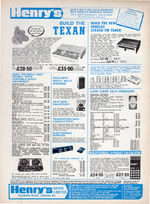 Typical Henry's Radio advert, 1974. Henry's was probably the largest supplier to the hobbyist market [click to see]Quite a few small electronics shops also operated a useful mail order service and 1960s and 70’s magazines were crammed with their adverts. A number of mail order suppliers came to the fore, including Henry’s Radio of London (Edgeware Road being the retail hub of all things electronic in Britain at that time), ElectroValue (an excellent, high quality supplier) and Lasky’s. Henry’s was notable as a post-war Government surplus supplier that retailed all kinds of audio and electronics kits, modules and surplus spares. Everyone had a Henry’s catalogue on their shelf, although it had the air of a jumble sale about it. (Henry’s re-invented itself for the 21st Century as Henry’s Superstore selling audio, PA and CCTV. Both ElectroValue and Lasky’s have long gone.) With a focus (literally) on home and workplace security, Henry's is now CCTV Centre.
Typical Henry's Radio advert, 1974. Henry's was probably the largest supplier to the hobbyist market [click to see]Quite a few small electronics shops also operated a useful mail order service and 1960s and 70’s magazines were crammed with their adverts. A number of mail order suppliers came to the fore, including Henry’s Radio of London (Edgeware Road being the retail hub of all things electronic in Britain at that time), ElectroValue (an excellent, high quality supplier) and Lasky’s. Henry’s was notable as a post-war Government surplus supplier that retailed all kinds of audio and electronics kits, modules and surplus spares. Everyone had a Henry’s catalogue on their shelf, although it had the air of a jumble sale about it. (Henry’s re-invented itself for the 21st Century as Henry’s Superstore selling audio, PA and CCTV. Both ElectroValue and Lasky’s have long gone.) With a focus (literally) on home and workplace security, Henry's is now CCTV Centre.
 1975: Home Radio (Components) Ltd had a glossy, traditional-style mail order catalogue [click to see]Rival supplier Home Radio (Components) Ltd. of Mitcham, established in the 1950’s, was proud of its catalogue that you actually had to (whisper) pay for! It contained numerous traditional-style illustrations for A&F Bulgin, Mullard and more, and the cover sported memorable artwork including Barbara Hepworth’s striking Theme on Electronics that I will write about separately.
1975: Home Radio (Components) Ltd had a glossy, traditional-style mail order catalogue [click to see]Rival supplier Home Radio (Components) Ltd. of Mitcham, established in the 1950’s, was proud of its catalogue that you actually had to (whisper) pay for! It contained numerous traditional-style illustrations for A&F Bulgin, Mullard and more, and the cover sported memorable artwork including Barbara Hepworth’s striking Theme on Electronics that I will write about separately.
The hobby electronics mail order sector was thriving and business was brisk at this time. Remember that the only way to buy parts was to phone up or fill in an order form and post it off along with a cheque or postal order, then sit back and wait for a Jiffy bag to arrive. However, the problem for the more discerning (or perhaps less resourceful) 1970’s hobbyist was that the supplier base was very fragmented and irregular. There were myriad independent sources of parts but overall, service could be very inconsistent; struggling with supply lines, they often made component substitutions, or delays meant it could take quite a while for parts to arrive in the post.
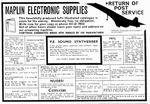 Early (June 1973) Maplin advert in Practical Electronics
Early (June 1973) Maplin advert in Practical Electronics
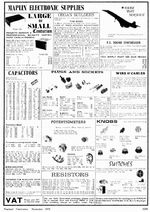 Maplin 1973 advert [click to see]GPO (General Post Office, now BT) engineers Roger Allen and Doug Simmons wanted to improve upon this scattergun approach and shake up the non-industrial electronics supply market. In 1972 along with Sandra Allen they set up a small components business of their own in a spare bedroom of the Allens' home. It was Maplin Electronics Supplies, in Rayleigh, Essex. Maplin’s core principles were to sell components exactly as advertised in the catalogue, and ‘supersonic same-day service,’ a strapline influenced by the new jet airliner Concorde that was taking to the skies in the mid 1970’s. Allen and Simmons adopted the name Maplin because the Maplin Sands had been earmarked for London’s third airport. In the event, Stansted became the third airport site instead, but the Maplin name stuck along with the promise of ‘same-day service’ i.e. your order would be despatched on the day they received it. (I recall dining in a Stansted pub in the early 80s which I learned was going to be demolished to make way for the new airport.)
Maplin 1973 advert [click to see]GPO (General Post Office, now BT) engineers Roger Allen and Doug Simmons wanted to improve upon this scattergun approach and shake up the non-industrial electronics supply market. In 1972 along with Sandra Allen they set up a small components business of their own in a spare bedroom of the Allens' home. It was Maplin Electronics Supplies, in Rayleigh, Essex. Maplin’s core principles were to sell components exactly as advertised in the catalogue, and ‘supersonic same-day service,’ a strapline influenced by the new jet airliner Concorde that was taking to the skies in the mid 1970’s. Allen and Simmons adopted the name Maplin because the Maplin Sands had been earmarked for London’s third airport. In the event, Stansted became the third airport site instead, but the Maplin name stuck along with the promise of ‘same-day service’ i.e. your order would be despatched on the day they received it. (I recall dining in a Stansted pub in the early 80s which I learned was going to be demolished to make way for the new airport.)
The Maplin Electronic Supplies catalogue
Maplin’s first catalogues were free, modest affairs (28 pages) offering a small, standardised range of bread-and-butter components and parts dedicated to some UK magazine projects. The catalogues would expand as exciting new components found their way onto the market. Maplin Electronic Supplies quickly established a reputation for fast turnaround, competitive pricing, stocking a wide range of everything that the hobbyist needed coupled with a consistently high and dependable service. Furthermore their catalogue started to introduce that elusive technical data for transistors and chips, making the Maplin catalogue an indispensable bible for many of its customers during the hobby’s heyday of the 1970’s and 1980s.
I would come to depend on Maplin for all manner of parts, tools and equipment, including my first oscilloscope, a British Scopex 4S6 that was grandly delivered by an important-looking Securicor courier in the late 1970s. (My dear late dad went to the Securicor parcel depot to fetch it specially.) Maplin had fitted a mains plug free, and popped a With Compliments slip into the box as well! (Fitted mains plugs only became compulsory from 1st Feb. 1995.)
Maplin's actual mail order form is here (PDF) - I owed them (bottom left) £1.19½p on carriage and Maplin already had a valuable loyalty voucher scheme (£1.00). The Securicor delivery note showed a collection address of Maplin Electric, Grange Road (?), Southend on Sea, and I still wonder where Maplin was located at that time. Possibly here: https://maps.app.goo.gl/nBGGi8pZmxovBXAx9
In short, business bustled and hobbyists could confidently send away for parts knowing that Maplin would send them with no fuss or bother. Usually anyway.
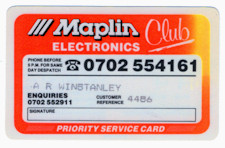 Maplin Electronics Club membership cardThe company’s first retail shop opened in Westcliff-on-Sea, Essex in 1975 and the mail order business moved in upstairs. In 1981 another store followed in Hammersmith, central London (see below). The Maplin catalogue had grown to 216 pages and went full colour for the first time in 1979. It continued to fill with new lines and its covers were bedecked with sci-fi artwork (https://www.google.com/search?q=maplin+catalogue - click 'Images') that became a familiar sight in every hobbyist’s worklab.
Maplin Electronics Club membership cardThe company’s first retail shop opened in Westcliff-on-Sea, Essex in 1975 and the mail order business moved in upstairs. In 1981 another store followed in Hammersmith, central London (see below). The Maplin catalogue had grown to 216 pages and went full colour for the first time in 1979. It continued to fill with new lines and its covers were bedecked with sci-fi artwork (https://www.google.com/search?q=maplin+catalogue - click 'Images') that became a familiar sight in every hobbyist’s worklab.
Maplin also created the Maplin Electronics Club, an order hotline and I see from my plastic card that I was Customer No. 4486. In an early and far-sighted example of EDI (Electronic Data Interchange), Maplin announced at the London Computer Fair in June 1983 that customers would be able to dial in over a landline and log into Maplin’s Cashtel (Computer Aided SHopping by TELephone) system, terminal-style, check stocks and place orders ‘online’. This was in an era where telecoms were very new and difficult, as this 1984 Youtube vid on how to send an email shows. Yes, home computing was taking off as a hobby in its own right, and Maplin was right in the thick of it. I found Maplin's Cashtel number from an old data sheet:
 Maplin's Cashtel Numbe
Maplin's Cashtel Numbe
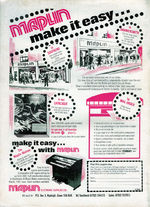 Late 1981 advert for Maplin featuring its two branches [click to see]From the early 1980's Maplin included its shop addresses (both of them!) in its adverts. Using Google Street View I could compare old advertising artwork with today's street scene:
Late 1981 advert for Maplin featuring its two branches [click to see]From the early 1980's Maplin included its shop addresses (both of them!) in its adverts. Using Google Street View I could compare old advertising artwork with today's street scene:
- Maplins' first shop is given as 284 London Road, Westcliff-on-Sea (now a nail bar) https://goo.gl/maps/BApbxRsrzc42 The advert artwork shows larger double-fronted premises, presumably 282-284 including next door's.
- Their first London site is given as 159-161 King Street, Hammersmith, London W6 See https://goo.gl/maps/axbCUBwzCXs In 2017, it is split into two, a coffee shop and e-cig seller).
By 1985 they had added three more shops:
- Manchester, 8 Oxford Road opened 16th August 1983 https://goo.gl/maps/EqAB6t4xo5C2 and https://goo.gl/maps/JcExwxfXptK2
- Birmingham, Lynton Square, Perry Barr.
- Southampton, 46-48 Bevois Valley Road https://goo.gl/maps/R9iTxKC9Gjv and https://goo.gl/maps/SHvs2NMPXLK2
If you have any more details or memories about these shops, please feel free to leave a comment at the foot of this page.
Electronics - the Maplin Magazine
 Maplin advert, 1982 [click to see]Maplin’s adverts became a permanent fixture on the rear cover of Everyday Electronics magazine for very many years.
Maplin advert, 1982 [click to see]Maplin’s adverts became a permanent fixture on the rear cover of Everyday Electronics magazine for very many years.
Maplin decided to dabble with publishing a title focussing on electromusic - Electronics & Music Maker - from 1981. It would start with the Maplin Matinee organ ('full kit from Maplin Electronic Supplies'). I found this item by its former E&MM Editor Dan Goldstein interesting. He claims the magazine was not seeing an increase in sales (for Maplin) and eventually they sought to hive it off. The October 86 issue would be the last before changing title to 'Music Technology'. More background and magazines scans will be found on the mu:zines website.
Maplin already had the supply lines and logistics in place to distribute their own kits of parts, and they published a whole raft of projects of their own design. Electronics - the Maplin Magazine was itself launched back in 1981 and became a rival to the established electronics titles that I worked for. It morphed into [The World of] 'Electronics and Beyond', and I understand its subscriber list eventually went to Elektor Magazine.
Maplin eventually dispensed with its hobby press advertising. Many hobbyists (but not all) increasingly preferred Maplin's ‘kitted project’ approach – everything could be shipped in a kit, there was no need to scratch around getting parts from multiple sources, and most importantly the projects were consistent and well sorted (I think some were even ‘CE’ marked, somehow*).
*CE approval of designs was never considered a problem for us: we published hobby projects and plans, and offered blueprints for individual assembly, but since construction was left to hobbyists we could neither quality-control the parts and construction nor warrant the performance of the finished item – put bluntly, it should work as expected if they followed the plans and built it properly! It would have been a sad day if the home construction of non-CE approved circuitry was banned. - AW
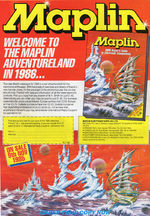 1986 Maplin advert with their sci-fi futuristic artwork [click to see]
1986 Maplin advert with their sci-fi futuristic artwork [click to see]
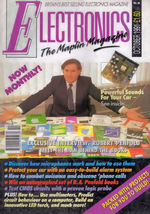 The Oct. 1991 issue of Electronics - the Maplin Magazine was the first monthly issue and featured author Robert Penfold on the cover [click to see]
The Oct. 1991 issue of Electronics - the Maplin Magazine was the first monthly issue and featured author Robert Penfold on the cover [click to see]
This news clipping from Everyday Electronics, March 1992 celebrated Maplin Electronic Supplies gaining the 'BSI Kitemark' for quality but it appears it's probably more to do with obtaining BS5750 (now, ISO9000) instead.
Shops galore
The nature of the electronics hobbyist was changing. As the hobby evolved and expectations increased, a new and upcoming generation of electronics enthusiasts saw no need (or was unable) to be resourceful like traditional constructors often were. Old hands in electronics had plenty of skills (including engineering, academic and theoretical ones), materials, stocks and workshop resources tucked away in the shed but a new generation was emerging that had neither the time nor inclination for that kind of thing.
It would be a sign of things to come, with constructors wanting (or needing) everything figured out for them and delivered in a DIY pack, cheaply, instantly and effortlessly, without struggling with life down at individual component level. Electronics could be a difficult and challenging, but highly rewarding, hobby to follow. As I explain later, the hobby would face more competition and traditional electronics would fall out of favour. How could Maplin survive?
The Altai tie-up
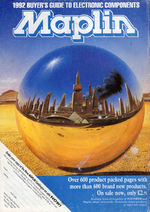 Way to go: 1992 Maplin catalogue advert: 'available from Maplin shops nationwide' [click to see]
Way to go: 1992 Maplin catalogue advert: 'available from Maplin shops nationwide' [click to see]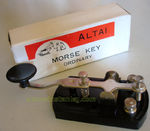 Altai was a cheap and cheerful brand of Chinese/ Japanese hobbyist parts [click to see]In 1989 Maplin's National Distribution Centre opened up in Wombwell, Barnsley in northern England. Buying offices were established in Taiwan (1993) and Hong Kong to source imports and the company was acquired by Cannon Street Investments plc, which had several businesses under its wings including the Altai brand of cheap and cheerful Japanese and Chinese parts familiar to many hobbyists. Cannon Street, later known as Saltire plc, snapped up Maplin Electronics (by then, a plc) in 1994. Maplin was having growing pains and with one eye on the future it sought a partner who had an electronics presence that would not conflict with Maplin's, said Roger Allen, and Saltire fitted the bill.
Altai was a cheap and cheerful brand of Chinese/ Japanese hobbyist parts [click to see]In 1989 Maplin's National Distribution Centre opened up in Wombwell, Barnsley in northern England. Buying offices were established in Taiwan (1993) and Hong Kong to source imports and the company was acquired by Cannon Street Investments plc, which had several businesses under its wings including the Altai brand of cheap and cheerful Japanese and Chinese parts familiar to many hobbyists. Cannon Street, later known as Saltire plc, snapped up Maplin Electronics (by then, a plc) in 1994. Maplin was having growing pains and with one eye on the future it sought a partner who had an electronics presence that would not conflict with Maplin's, said Roger Allen, and Saltire fitted the bill.
 Maplin MPS (Maplin Professional Supplies) advert 1996Saltire wanted to integrate Altai with Maplin’s systems and target the electronics trade side of things under its MPS – Maplin Professional Supplies, launched back in ‘85 – brand as well. MPS had been generally and surprisingly well regarded by the electronics engineers that I knew, and in addition Maplin would dish out nearly a third of a million hobbyist catalogues in ’95 as well. The Maplin brands and MPS were eventually merged in 1996.
Maplin MPS (Maplin Professional Supplies) advert 1996Saltire wanted to integrate Altai with Maplin’s systems and target the electronics trade side of things under its MPS – Maplin Professional Supplies, launched back in ‘85 – brand as well. MPS had been generally and surprisingly well regarded by the electronics engineers that I knew, and in addition Maplin would dish out nearly a third of a million hobbyist catalogues in ’95 as well. The Maplin brands and MPS were eventually merged in 1996.
The year 2000 saw Maplin shut down its Southend distribution site and consolidate in Wombwell before moving to a purpose built distribution centre and head office in Rotherham (Google Maps). The firm's former Wombwell site lay empty for some years until Naylor Industries, a construction firm, bought the premises. In Google Street View, the old 1990's Maplin logo adorns the now-demolished Goods In gatehouse at Wombwell (see Google's June 2009 capture) but the site is all but abandoned. You can get a glimpse of the site's new owners here (2016).
Maplin’s first “Mondo” superstore, a 9,000 square foot retail outlet, opened in Leeds in 1995, and its chain of retail stores would then proliferate as we have all seen, and it would change ownership a number of times. I understood (late 1990’s) that the major UK/ US electronics distributor Farnell (a major rival to RS Components) considered buying Maplin at one time as it pondered moving into retail. However Farnell must have got cold feet as they bought the retail- and trade-facing mail order (only) supplier CPC instead. In 2001 Maplin had an MBO with the backing of Graphite Capital, and another in 2004 backed by Montagu Capital (see later).
Gradually, another problem surfaced: hobbyists would buy their latest electronics magazine or start on a new project, expecting to walk into their nearest Maplin store to buy the parts, but it became clear that expectations were too high and the idea of every store stocking everything off the shelf was just not viable. Their useful discount voucher mailshots stopped arriving. People started to chunter, a bit unfairly, that their local Maplin shop didn't even have a basic transistor in stock any more, and they were ordering online from RS or Farnell instead. Maplin's marketplace was changing.
The changing face of hobby tech
Some key factors contributed to a storm that was brewing, and in my view the seeds of Maplin's downfall were sown many years earlier. By the late 90s, electronics as a traditional and wholesome hobby was rapidly decoupling itself from its original pipe & slippers roots, ones that were established in the 1950s and 1960s. For starters, ‘hard core’ electronics is quite a difficult subject to get into, both academically and practically, and it was no longer being taught in schools the same way it used to be. EPE Magazine operated (and still does) at electronic component level, grappling with the core principles of physics behind every last resistor, capacitor, inductor and semiconductor, whilst publishing lengthy tutorial series aimed at beginners or students in electronics. As well as practical skills, some gruelling theory and complex formulae came as part of the hobby electronics package during this time.
It would be true to say that hobby electronics was gradually being dumbed down, and arguably traditional hobbies themselves (electronics, stamp collecting, Airfix modelling, anyone?) risked being consigned to yesteryear. Technology was becoming more useful and user-friendly. I feel the new generation of enthusiasts was being turned off by the sheer effort of understanding the subject, not helped by the absence of schooling in a pure electronics syllabus. Some radical changes in electronics technology were also filtering through to the hobbysphere, starting with miniature SMT (surface mount technology) parts, tiny chips not much bigger than a match head that supplanted larger-size ‘discrete’ components that were easily soldered by hand by hobbyists.
Controlling with microcontrollers
A more fundamental and unstoppable change in hobby electronics technology was evolving, though. As from the late 1990s, instead of puzzling over how to solder together large circuit boards of individual logic chips (for example), hobbyists started programming microcontroller chips instead, including the Arizona Microchip PIC family that EPE Magazine majored on. Only a tiny handful of extra parts were needed to make a powerful project, so the hobbyist’s skills evolved into programming chips and (sometimes) soldering tiny surface-mount chips into place. Compared with their forebears, this empowered constructors to do far more productive things using cheap, modern electronics technology. They also started to play with the Raspberry Pi and Arduino single board computers and computer science, not soldering stuff together, came to the fore in schools. A whole new segment of ‘makers’ was also opening up and most of the action was happening not in retail stores or magazines, but online instead.
The advent of the home computer, video entertainment, digital cameras and smartphones, MP3 music and the exciting new Internet created more competition for a person’s pocket money. Electronics magazine sales were in decline (but despite dire predictions, the Kindle or PDF would not finish off print magazines any time soon). There was far less need for new hobbyists to be resourceful and there was more money to splash around on their hobby as well.
I noticed how in the early-mid 1990s readers’ own circuit submissions (for magazine prizes) could easily fill half a dozen magazine pages every month (in the 60’s there were 500 in one week, sometimes), but that dropped to zero in a short space of time during the latter 1990s. That was a sure sign that the mainstream hobby electronics enthusiast was moving on: it largely stopped experimenting with traditional electronics circuitry of the type that Maplin had been founded on. Clearly, people were building fewer traditional electronics projects and were doing things with PCs and microcontrollers instead. Later they would start with the Raspberry Pi, Arduino, BBC Microbit, robotics or maybe flying drones. A hard core of constructors still existed though: they retained the old-school skills of resourcefulness as well as academic and technical expertise.
The new trends in hobby electronics and technology, which mirrored the electronics industry anyway, popularised pre-built modules and powerful, miniature (and dirt cheap) single board computers, with less need to understand component-level physics or tricky maths any more. Maplin would go on to retail some of these modules, also trying to tap into the market for drones, computers, buggies, toys, Internet of Things etc. I suppose the feeling was that Maplin stores were useful for things that you needed urgently, but savvy constructors thought they were a pretty expensive last resort and had gone the way of Tandy/ Radio Shack stores.
In financial freefall
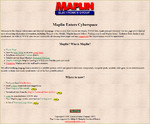 Maplin's first web page... designed in the Gateshead branch! (1996) (Archive.org)The company went through a Management Buy Out in 2001. The commercial and structural aspects of Maplin’s gradual downfall have been well documented, but I found this analysis by financial blogger Frances Coppola quite thought-provoking, especially if you know your Mezzanine finance from your Series ‘A’ notes (not that I do, but my accountancy qualification helped unpick the gist of it).
Maplin's first web page... designed in the Gateshead branch! (1996) (Archive.org)The company went through a Management Buy Out in 2001. The commercial and structural aspects of Maplin’s gradual downfall have been well documented, but I found this analysis by financial blogger Frances Coppola quite thought-provoking, especially if you know your Mezzanine finance from your Series ‘A’ notes (not that I do, but my accountancy qualification helped unpick the gist of it).
Here it is claimed that during Maplin’s latter years, buckling under the weight of its holding group and private equity funding, its profits were forcibly drained by dividend payouts and interest payments and from 2005 onwards, Maplin was technically financially broke, on paper anyway, with the holding group declaring debts of nearly half a billion pounds. The suggestion has been made that the once-successful Maplin had been turned into a debt-ridden, zombie basket-case of a company. It wasn't so much the core Maplin business that was the problem, as that was being turned around, but the corporate layers above it that crippled the company.
For four more years an ailing Maplin received life-support after being bought by Rutland Partners, a specialist that turned around distressed businesses. Ultimately however it was the top layer of a very convoluted corporate structure that crashed and burned, taking the Maplin brand with it.
The story told is one of a slow car crash that headed inexorably over the cliff when, it is claimed, the last group of financiers (Rutland Partners) paid far too much to buy Maplin and in turn borrowed money to fund the purchase, then overloading Maplin with debt as had already happened previously. It would only be a matter of time before the ship finally sank. Credit insurance was gradually withdrawn at the end of 2017 and suppliers would only deal in cash. In February 2018 the Closing Down posters went up in Maplin’s stores across the country.
Buy It Yourself!
I wrote earlier that the Internet would also influence things, as the web and social media now allowed constructors to share ideas or publish their own project notes online, all for free. But the web had another major effect on the hobby marketplace: obviously, hobbyists could now source parts for themselves online, often importing direct from the Far East or via eBay for a fraction of the cost of a traditional retailer. As debt-laden Maplin needed to stock its 200+ stores with fast-moving electronics parts and gadgetry, it was no contest and they could never hope to compete with the seismic change that the internet created in their marketplace. Very simply, geeks and gadgeteers were now buying online. What Maplin was trying to do would prove incompatible with the needs and budgets of British buyers.
Maplin would try to re-invent itself by offering trending lines of Internet-of-Things, gadgets, smart home networking devices and Google Home etc. but I personally noticed that hardly anybody was looking around their fresh, new, smart, clean stores. It was like being all dressed up ready to party, but there was no party. It’s a sad fact that not once did I see a Maplin store (there were three in my locality alone) that I could honestly describe as buzzing with trade. Although they had some bright and helpful staff to help bolster sales or provide support, in my view the critical footfall just wasn’t there. This was particularly noticeable during the Christmas 2017 shopping season: everyone was ordering their latest goodies from Amazon, eBay and places other than Maplin, and sadly the stores were all but empty.
 Maplin's website finally closed on 30th April 2018, bringing the shutters down on its online presence for ever.Maplin's website finally closed on 30th April 2018, just as I was finishing off this piece. Maplin probably collapsed under a conspiracy of corporate debt, over-expansion into retail stores, coupled with a fundamental shift in the needs of its core marketplace and the customer’s inexorable move to buying online at rock-bottom prices anyway. Added to the woes of carrying tech inventory with a relatively short shelf life, or carrying myriad specialist lines that there was little demand for, and Maplin would eventually be overwhelmed by competition from the changing faces of modern retailing and electronics technology itself.
Maplin's website finally closed on 30th April 2018, bringing the shutters down on its online presence for ever.Maplin's website finally closed on 30th April 2018, just as I was finishing off this piece. Maplin probably collapsed under a conspiracy of corporate debt, over-expansion into retail stores, coupled with a fundamental shift in the needs of its core marketplace and the customer’s inexorable move to buying online at rock-bottom prices anyway. Added to the woes of carrying tech inventory with a relatively short shelf life, or carrying myriad specialist lines that there was little demand for, and Maplin would eventually be overwhelmed by competition from the changing faces of modern retailing and electronics technology itself.
It is quite ironic, I suppose, that in the end the vagaries of the technology that Maplin sought to sell was also instrumental in ensuring its untimely demise as a retailer. It has been a blast - thank you, Maplin, for all those little padded bags of electronic parts that I eagerly anticipated arriving in the post, back when I was a 1970s schoolboy.

- Maplin Hammersmith I found this post on an Atari forum which gave an insight into life at Maplin's Hammersmith store.
- Catalogue covers I found tons of cover shots of old Maplin catalogues and PR etc on Pinterest, worth a trip down memory lane! Do you recognise the original Concorde catalogue covers? I do!
- Brief history of Maplin (Everyday Electronics & Electronics Monthly, Nov. 1985) PDF
- Maplin's final 'wave' (goodbye?) logo and livery alluded to the connected home and were designed by blue-chip London-based SomeOne as this PR review explains. They probably couldn't have picked a better agency to rebrand the firm, and if that wouldn't do it, nothing would.
- Inside Maplin's massive empty warehouse - Rotherham Business News, 2018
- This interesting note (PDF) prepared by Richard Murphy FCA of Tax Research LLP for ITN News analyses the impact of venture capitalists on Maplin's downfall and questions whether VCs still have a role today.
- (November 2018) The Maplin brand name is being re-invented as a mail order/ online gadget business. Seems it's presently stuck in the wings. See www.maplin.co.uk
- Roger and Sandra Allen celebrate their golden wedding (congratulations!)

 Friday, April 27, 2018 at 10:23PM
Friday, April 27, 2018 at 10:23PM
Reader Comments (8)
This Tweet about sums up the end of Maplin:
Maplin Tweet
(Fitted mains plugs only became compulsory from 1st Feb. 1995.)
I guess that explains why the 25 watt Antex soldering iron that I bought from Watford Electronics and had shipped to me in NZ in the early 1970s came with no mains plug - I had until now always thought that they had simply saved me the hassle of removing the UK plug and installing my NZ/AUS plug and perhaps saved on shipping to NZ.
It's hard to believe today but pretty much every (British, anyway) electrical appliance used to come with no mains plug attached. People had to learn how to wire a plug safely and also what fuse rating to use depending on power consumption. Even a simple table light, you had to fit your own plug!
It is indeed very sad that Maplin has finally folded. I made my first project (Mains Drill Controller) from the Maplin magazine and still have and use it. A lot of projects from the Maplin magazine I still have and use. The 20 watt MOSFET amplifier (Maplin magazine No 2) I still have and use it. The Maplin magazines Electronics and Beyond and the Maplin Project books are now available in PDF format on this website. http://www.americanradiohistory.com/index.htm
Now Maplin has resurfaced and was bought by Peter Duncan from Dragons Den. Though the resurrection seems to be similar, if not the same as the old ways, which brought them down. Just selling tat, where so many other companies sell the same at cheaper prices. Sadly, I can see it going under again.
Great article, thanks Alan. From about 14 years old I'd flick through the Maplin catalogue from cover to cover until I virtually knew every component on each page. How sad, but very interesting! I built many things using Maplin components. Guitar effects, PC interfaces etc. When they started selling more toys and gadgets, and less components, you knew the end was coming. Happy memories.
The first cracks with Maplin began to appear late in 1999 as I recall, there was a fantastic ride into the 1990s and then late into 1999 the catalogue became, I don't know, blander, the cover became very plain (I seem to recall it being white as a sheet with no artwork on the front or back). That was around the time I stopped ordering from them because others had arrived, and also because I became an engineer, I was exposed to the big boys (suppliers like RS, the sales reps of all the big silicon companies such as Motorola, TI etc) who would dish out samples and devkits like candy.
Electronic engineering, as a whole, has become a dumbed down pile of poo especially now that nobody has to think or do math anymore. Just buy an Arduino shield, made in China with shoddy documentation and it will work. I got out of engineering because by 2014, everything was being done in China to ensure the shareholders got richer and used as an excuse to pay me less and less. I also got motivated to turn my back on this entire industry and hobby because by 2015, I had been doing work for people, typical Arduino fanboys, who thought you could tack an Arduino Uno to a breadboard and make that a saleable, manufacturable product. They just wanted me to lay out the PC board but blamed me when the software hung, and also blamed me when the unit blew up at the slightest bit of industrial rigour (i.e. noise, power surges, etc). These days any old fool who can put an Arduino together fancies himself an engineer, and sees those of us who paid our dues in university/college getting a degree, as noisy old fogies.
Its 2022, and I earn my money writing software within the payment industry. My work centers squarely with EMV and the processing of card transactons. Its a world away from soldering irons, components and more, which I do privately and on my own because frankly I couldn't be bothered to argue with the youth of today that knows everything.
This is a lovely article - glad it was written!
I lived in Southend and remember my first visit to the original Westcliff shop where it felt like a jumble of everything electronics, you went in one door and navigated around all the narrow shelves of components in little bags before you struggled round to the cash desk. They had racks of storage drawers of the little/delicate things. It was busy at the time and on many of the times I went back at the weekends after...
I can't remember when they adopted the shopping list system but I remember spending hours with the catalogue working out components I needed, writing them all down and taking them in to be picked... Being excited to get the components to take away, but also a bit nervous about being in a grown up shop alone (think I was 10/11).
Have a lot of big memories like when they moved to the new shop on the other side of the road and sold more general electronics and the components became more hidden at the back, I remember blue LEDs becoming a big thing and the chap behind the counter telling me to save my money because they weren't very bright but also slowly them running out of components before the counter was always unstaffed and then unstocked while the other things like overpriced computer components (we always got ours from computer shows) and random gadgets like heated slippers started popping up.. then we had 2 shops in the town which seemed too many, then they were everywhere in the city and then they all closed. I nearly bought one of the racks of component drawers in the closing down sales, kind of regret I didn't because it was such a big thing of my growing up in electronics!
Still get frustrated waiting for resistors to arrive and miss the catalogue to flick through and discover new chips (the noise generators were always a favourite), but also love the simplicity of an Arduino or ESP32.
A lovely trip down memory lane and now I remember where the original shop was (still a nail bar!)